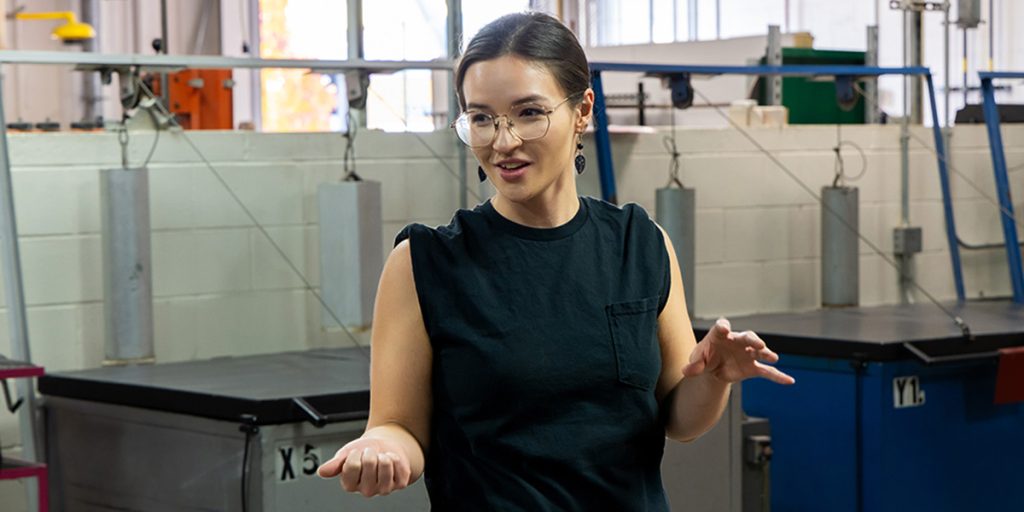Graduates of the UW–Madison School of Education are enjoying successful careers in fields across the arts, health, and education — and we are excited to share what they are doing today.
Following is a Q&A with Abby Sunde, who graduated in 2024 with a BFA in Studio Art.

How did you get interested in this field/major? How did you decide that UW–Madison was the right place to pursue this degree?
I’ve been interested in art all my life, but I was first introduced to glass through a class project at Normandale Community College in Bloomington, Minnesota. From that first glass project, my life completely changed and I knew I needed to learn more about this fascinating material. Through my professor’s kind recommendation and encouragement, I continued on to study glass at UW–Madison, which has led me to where I am today.
What are you doing today (professionally, or where are you pursuing further education)?
I’m currently a Presidential Fellow at Rhode Island School of Design, pursuing an MFA in Glass. This year I’m also excited to be a collaborating artist with Writing the Wild, a wonderful cohort-based organization focused on supporting writers through an eight-month writing journey of workshops, gatherings, and prompts.
What was your most meaningful experience with the Art program?
My most meaningful experience was getting connected with the Glass Lab at UW–Madison. The community there fostered my curiosity and love of glass while encouraging me to delve deeper into my studio practice.
What class or professor had the greatest impact on you, and why?
Professor Helen Lee and Professor Fred Stonehouse were both such significant figures in my time at UW–Madison and I am so grateful for their generosity, insight, and all the advice they gave me during my time there. My independent study with Professor Stonehouse led to some of the largest moments of growth in my practice. Professor Lee helped shape my understanding of the glass world and how one operates within these spaces while staying wholeheartedly committed to community-building and facilitating diversity, equity, and inclusion. I’m truly grateful for the care they showed me and believe it speaks to the quality of the instructors that UW–Madison has within their Art program.
How, if at all, has the Art program at UW–Madison helped you get to where you are today?
I would not be where I am today without the Art program at UW–Madison. Through this program, I was able to explore my interests in art and really focus towards my goals as an artist. The support from professors, peers, and academic advisors helped mold my path forward and I am indebted to so many folks here.
Can you tell us about a time when an academic advisor helped you?
Matthew Mauk was a great resource throughout my time at UW–Madison, helping ensure I was on track for graduation and connecting me with resources. Advisors like Matthew Mauk are such a significant support system to students, and I appreciate the time they take to support their students. Laura Hiebing, who is now the Indigenous Student Services Coordinator at UW–Madison’s Academic Coaching to Thrive & Succeed (ACTS), was also such a huge part of my journey. Through Laura and the Network for Development & Growth of Indigenous Scholars (NDGNS) program, I felt so supported and knew whether I needed someone to talk to or help navigate a situation on campus I would truly be seen and cared for by them.
Have you participated in any research, study abroad, or community service? What did you participate in and could you talk a bit more about those experiences?
While at UW–Madison, I participated in The Flow Project by Water@UW–Madison, which connects artists with scientists in a partnership where the artists create work inspired by the scientist’s research. Through that project I was partnered with Geoff Siemering, a researcher in the Department of Soil Science. We hit it off and worked together through a community-based water research grant funded by Water@UW–Madison and the Morgridge Center for Public Service. Through that grant and funding by UW–Madison’s Earth Partnerships, we supported a citizen scientist group in their summer research to determine harmful impacts to the landscape caused by an oil pipeline installation in Northern Minnesota. These experiences were a beautiful confluence in science, art, and the ability to support the community around us. As someone who used to work in the sciences, I see opportunities like these as the ways in which I can live out my values and support the people and the earth around me.